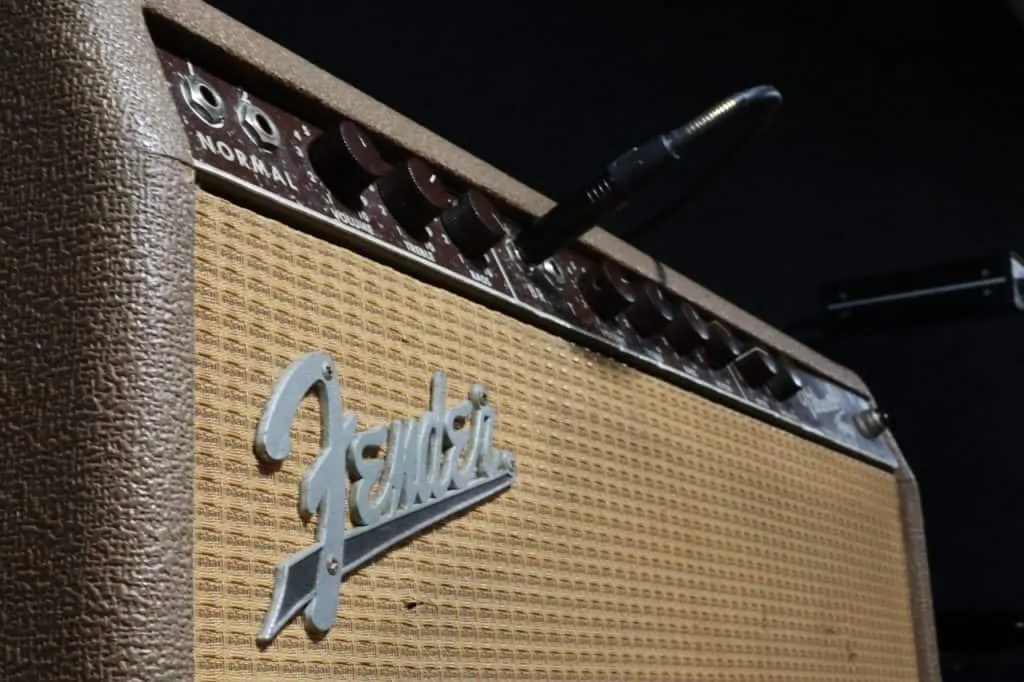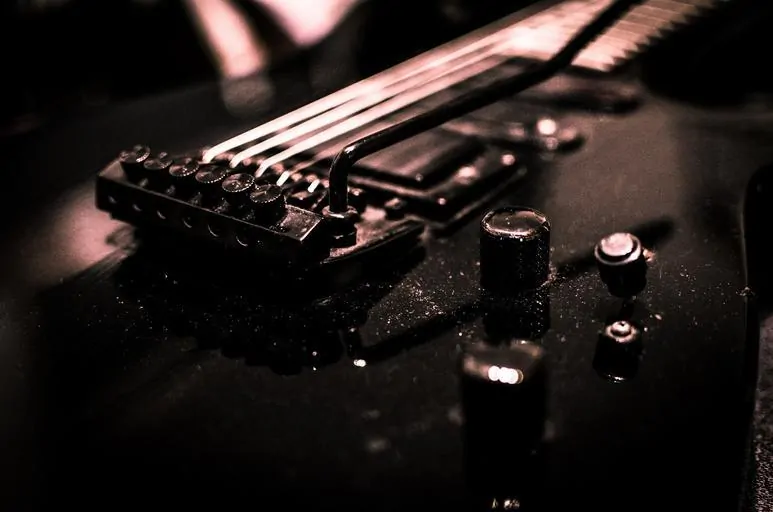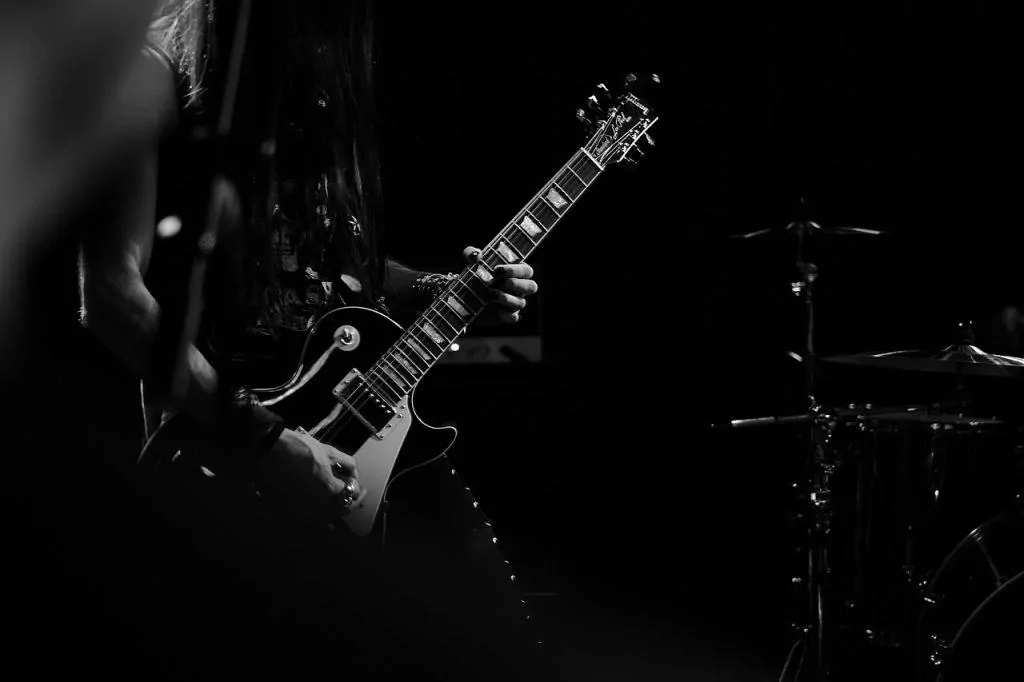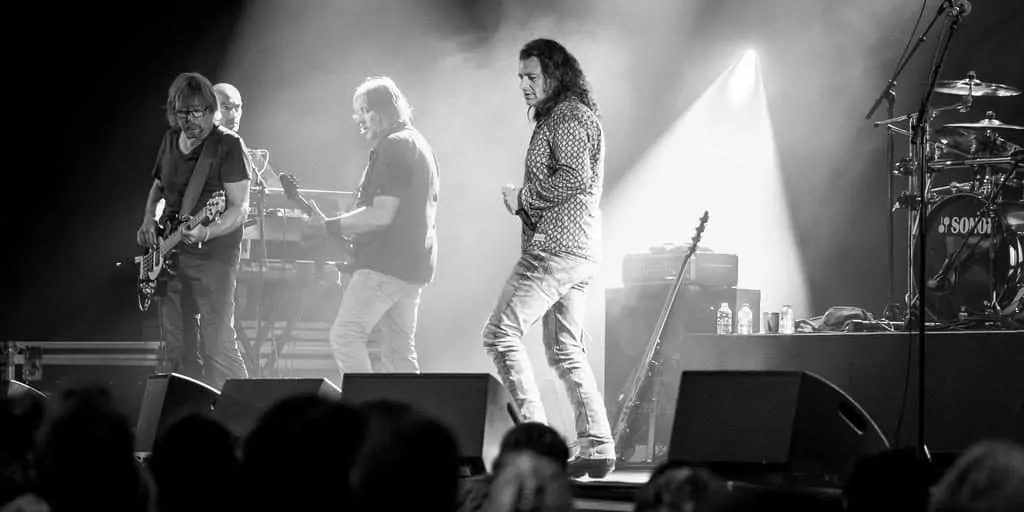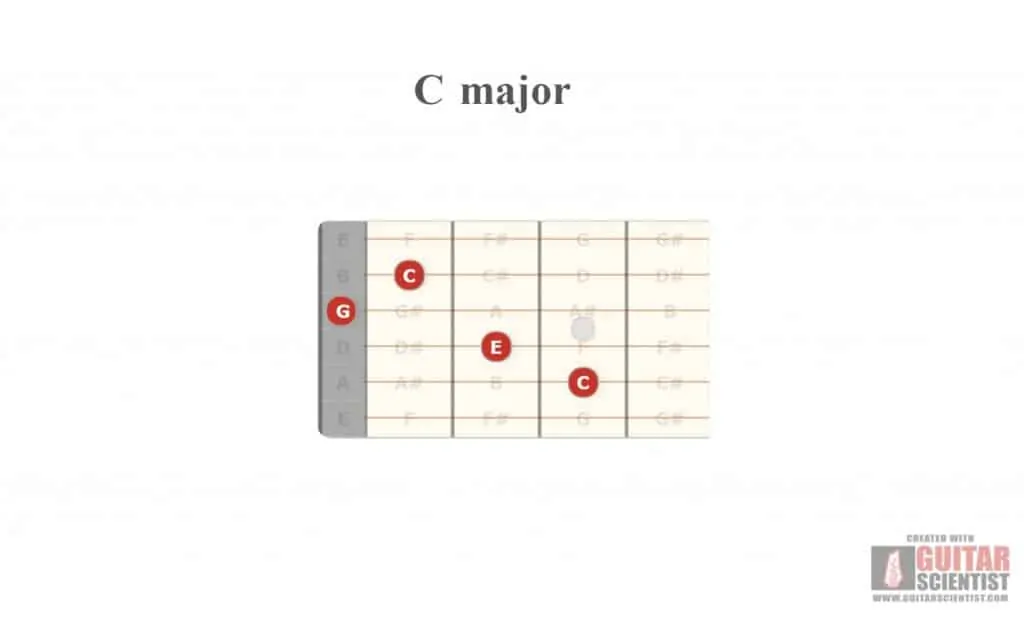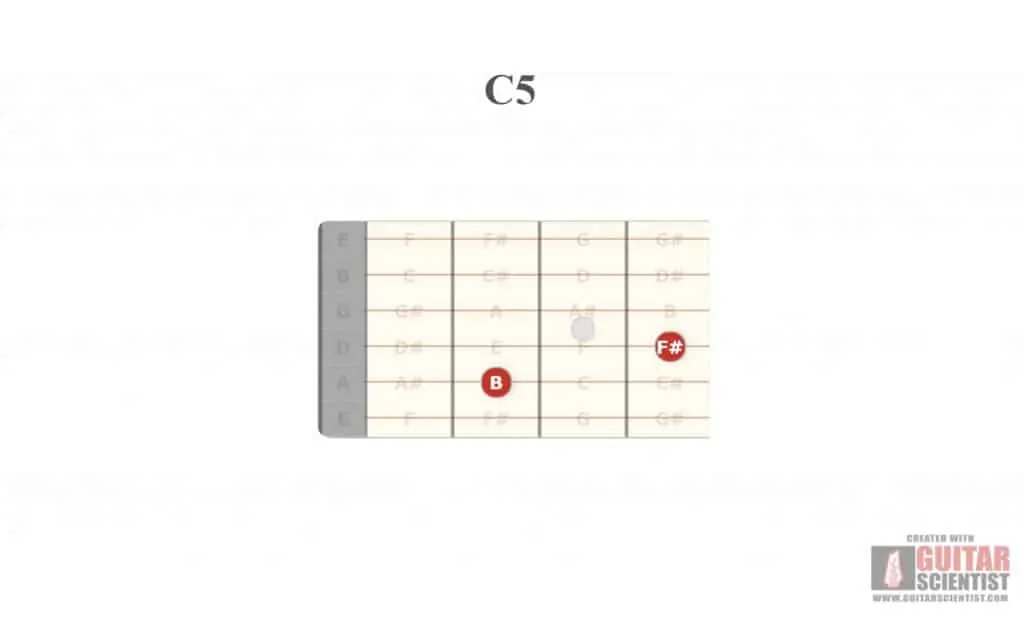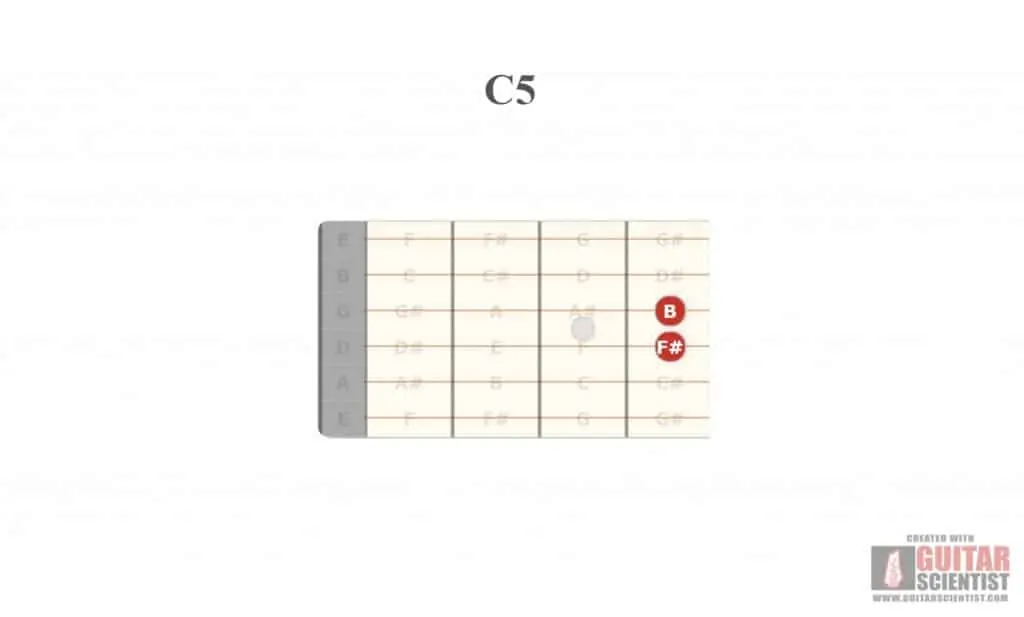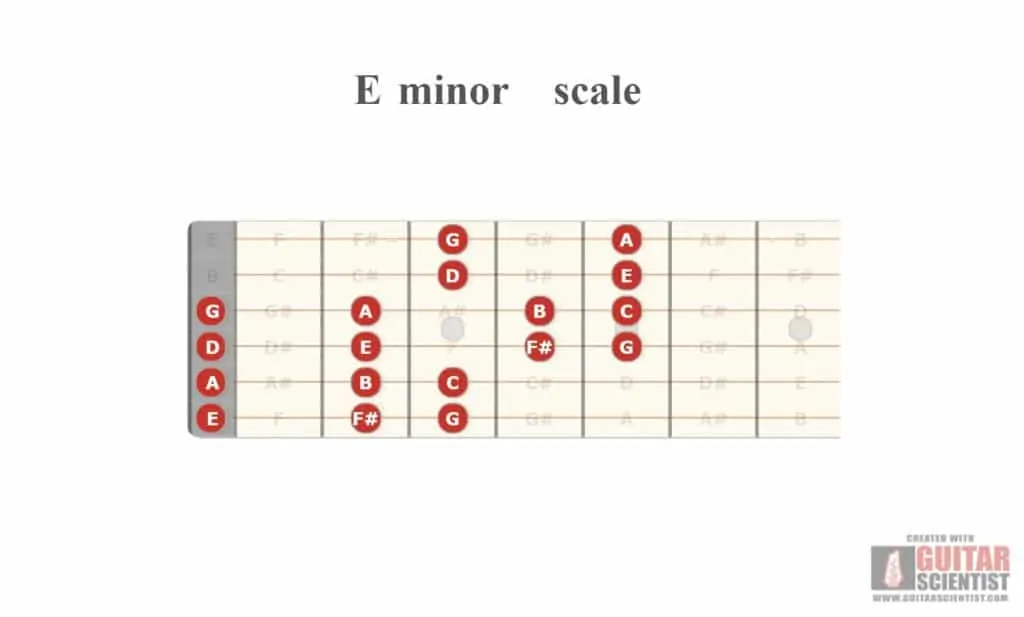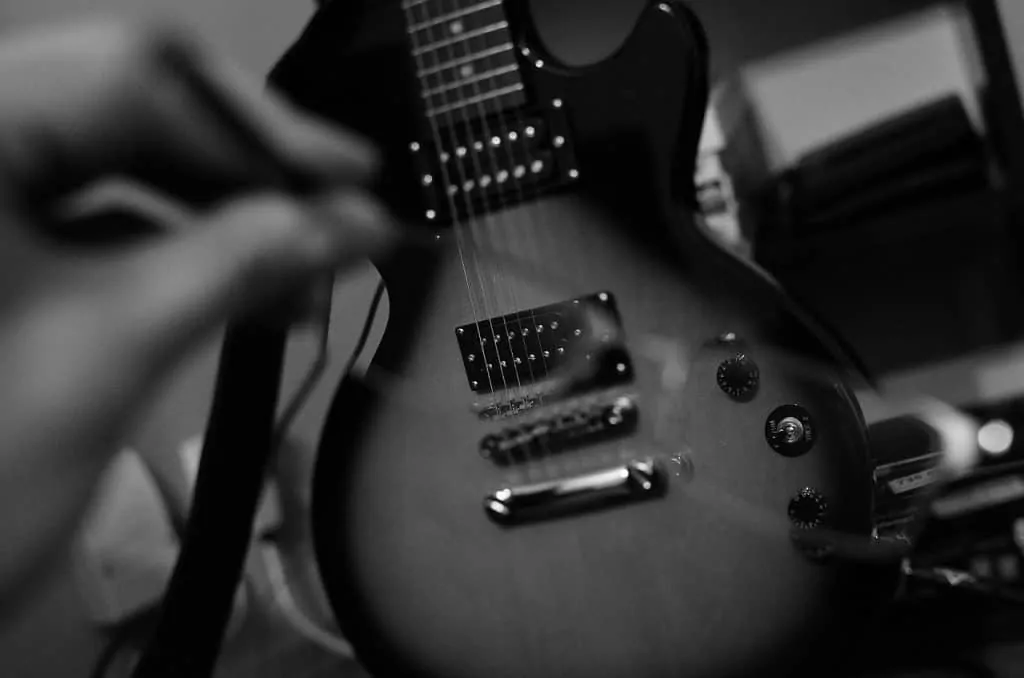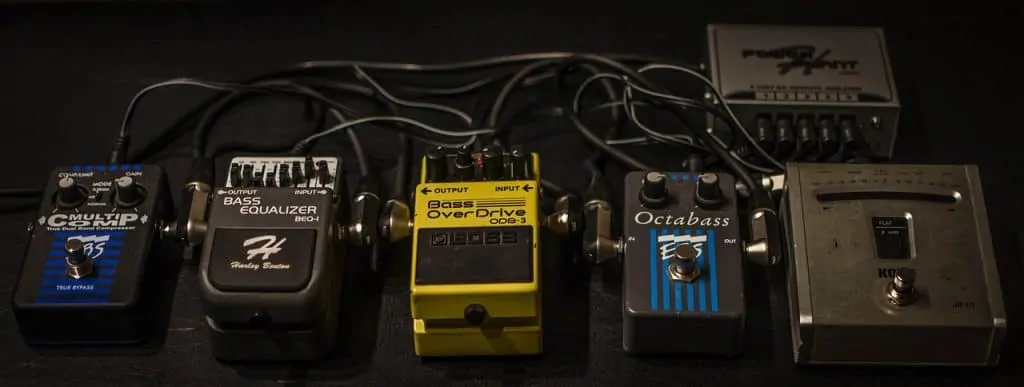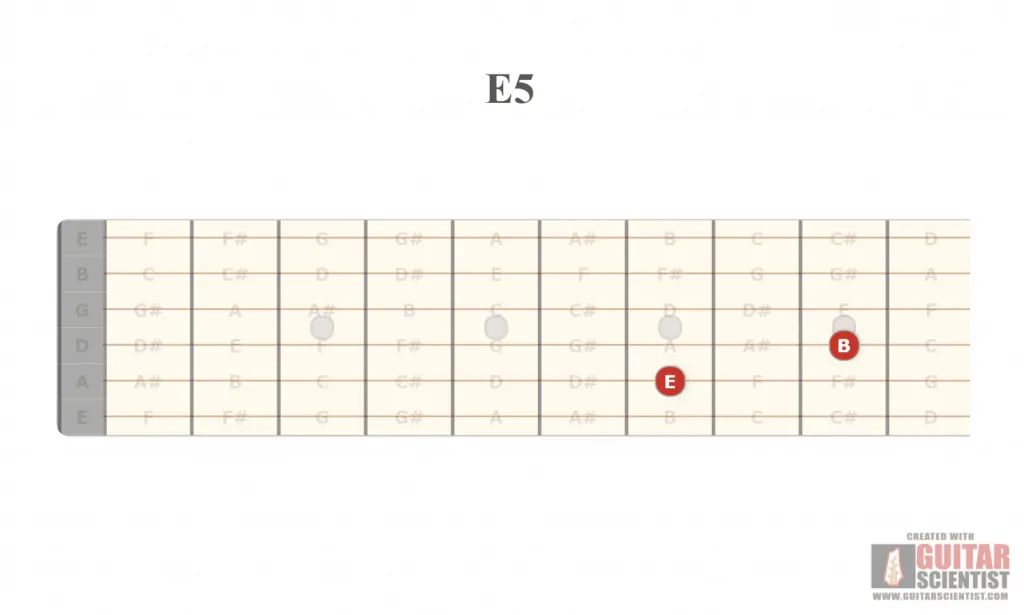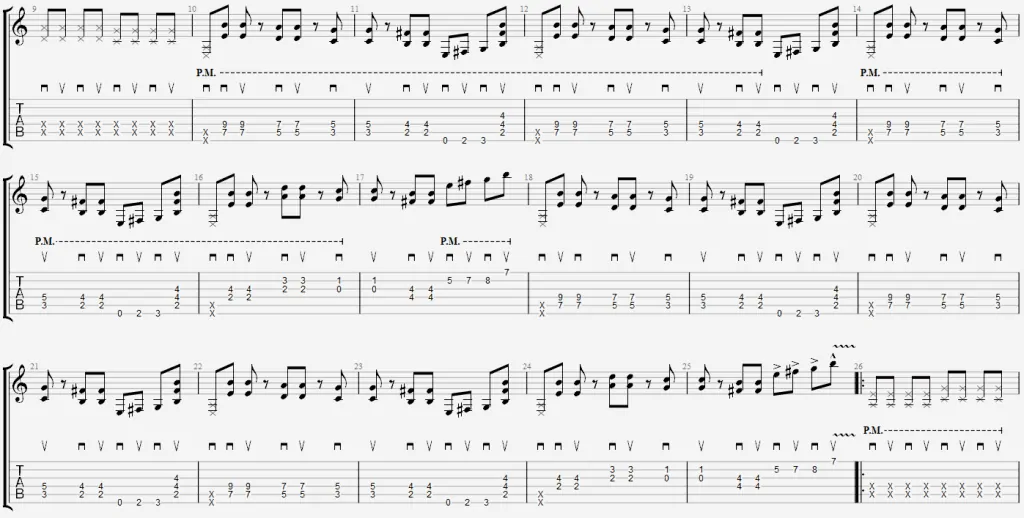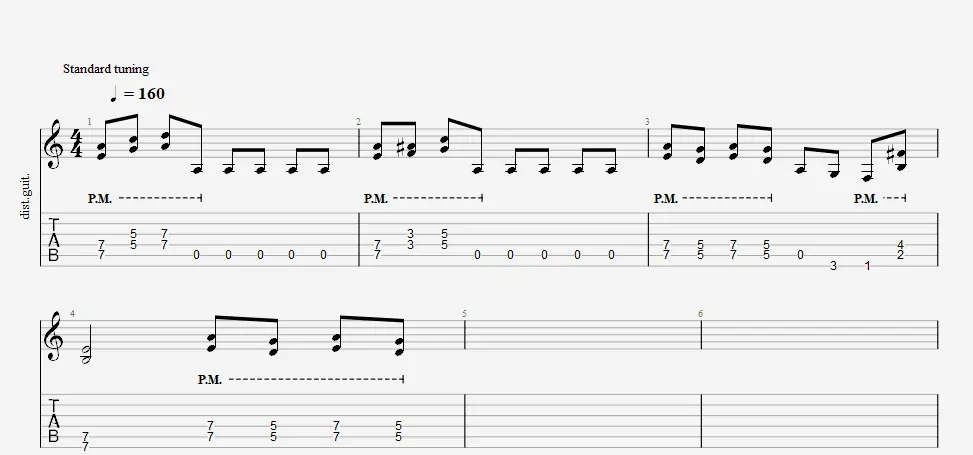Many people, including me, first come to the guitar with metal music in our ears. As powerful as it sounds, though, playing metal is not particularly easy.
Sure, you could crawl your way in and out of the song with only power chords (more on that later). However, if you want to accompany your rhythm guitar partner, you’d need to learn some new tricks and tools to forge your own face-melting metal riffs in any song you play.
What we’re going to do is understand what a riff is so you can create it from scratch. Having knowledge of a musical resource is a great creative tool. So, we’re about to analyze recurring patterns, techniques, and motifs, and then deliver a method you can follow.
Keep in mind the metal genre is built on power chords, melodic progressions, gentle arpeggios, and chordal figures, riffs, licks, and solos.
Consider the following: rock & roll is blues’ prodigal son. And heavy metal is an offspring of both.
So, the point of this article is to guide you through a heavy metal journey. I want you to check and listen to all of the videos I’m posting below because they still present a great influence on the genre and might become a great influence for you.
Learning how to play a metal riff is also seeing how the great guitar players did it before you.
So, by the end of the article, you’ll have a full inventory of heavy metal bands and songs, and you’ll be able to follow my metal riff spreadsheets showing you notes, progressions, chords, rhythm patterns, and more.
Contents
Following this guide, you will learn:
- The history of the metal genre;
- Heavy metal subgenres;
- What is a metal riff?;
- Plying heavy metal riffs;
- Creating your heavy metal riff;
- Advanced metal riffs;
- Final considerations.
In the meantime, here’s a rundown of some of the best metal riffs of all time.
Where does metal come from?
Heavy metal is a rock music genre born in the ‘70s decade. The genre includes many styles of virtuosic, powerful, and intense music driven by distorted electric guitars and heavy drums.
Cultural site Live About explains Heavy Metal is the wide umbrella that characterizes aggressive, loud, and guitar & drums-filled music. Melodic and less complex metal subgenres are usually more mainstream, while underground subgenres are more complex, powerful, or experimental.
Heavy Metal was born in the ‘70s.
The history of the heavy metal genre
Recognizing the origins of heavy metal is simply reviewing the history of four historical rock bands. In simple terms, the music came to light naturally, organically, as if it were a message from beyond.
It wasn’t part of any particular movement or any particular theme. And, still, it started to rear its pointy hear at the same time from various corners of the world.
However, there’s one element that definitely influenced the origins of the genre: bigger and louder guitar amps. Rock star Peter Townshend asked sound engineer Jim Marshall to create bigger amps in 1964. In return, Marshall delivered the first 100-watts tubular amp in 1965. You can read more about it in our prior tubular amp buyer’s guide.
As amps became meaner and more advanced, rock musicians gained new freedoms to play. In heavy metal terms, they began to have increased leeway to experiment with high gains. Most of all, they could now punch the volume knobs higher while playing with distortion.
Tubular amps use empty glass tubes on the cabinet to amplify the guitar’s voltage.
The birth of heavy metal in four mythical rock bands
The term “heavy metal” was born in the song “Born to Be Wild” by Steppenwolf (1968). The Canadian band described the song as a “heavy metal thunder” and gave way to a musical movement. They played from 1960 to 1970.
There’re debates, though. Some experts consider Black Sabbath to be the original precursors of heavy metal. They released their first single, “Evil Woman” in 1970 (part of their debut album, 1971’s “Attention! Volume 1.” More so, the USA band began playing in 1968, so it’s hard to say which band first influenced the world.
The rock quartet led by frontman Ozzy Osbourne and guitar player Tommy Iommi is still one of the greatest influences in rock history.
Osbourne successfully led the band into a more sinister, almost satanist vibe than their contemporaries. His stage presence, lawless behavior on and off the stage, and growling vocals were a major difference with bands like The Who, Led Zeppelin, and even Jimmy Hendrix, already teasing heavy metal all over the world.
On the other hand, Iommi is indeed considered as the creator of the power chords, used in almost every rock and metal song since the Black Sabbath days.
It wasn’t just Iommi’s doom, distorted guitar lines which basically created the heavy metal sound.
You see, when Iommi was a teenager, he worked at a factory, and because of an accident, he lost the tip of his middle and index fingers of the right hand. It happened in Birmingham, 1965, just a day before he got on his first tour with a band he just joined, The Birds and The Bees.
Instead of abandoning guitar altogether, he set to figure out ways of playing around his disability: he used lighter gauge strings, dropped tunings, and played easier chords that required him to press just to strings, so he could rest his disabled fingers. Thus, he created the power chords and the sound of heavy metal.
Tommy Iommi uses custom LTD or Gibson Les Paul guitars.
We also add Led Zeppelin into the mix as one of the first metal bands in history. John Paul Jones, Jimmy Page, Robert Plant, and John Bohnam played together between 1968 and 1980. The Zep is still one of the most influential rock bands ever, and their music still sells and plays on mainstream radio, TV, and cinema.
The mythical British band launched its homonymous debut album in 1969. They composed, recorded and mixed the 9 songs of “Led Zeppelin” in just a week.
This is an album that includes “Good Times, Bad Times”, “Babe I’m Gonna Leave You,” “Dazed and Confused,” and “Communication Breakdown.”
These songs already included landmarks for the heavy metal genre: gentle arpeggio sections, long medley sections with ripping guitar solos, powerful chorus with heavy distortions, and a lot of drum presence. And, most of all, a combination of blues and rock influences with heavy distortions that would set the sound of generations to come.
During their first European tour, the group had the play in Denmark under the name The Nobs, as baroness Eva Von Zeppelin, descendent of the Zeppelin inventor, hated the band and said they were “screaming monkeys.”
However, the album wasn’t popular in the United Kingdom, so the band went on tour to the United States. Soon enough, they became widely popular in America and the press qualified the “Led Zeppelin” album as heavy metal because of the explosive live presentations of the rock quartet.
Frontman Robert Plant wasn’t very eager to be classified as heavy metal by the time. He said “one third” of their music was acoustic, so it made no sense to him.
The band disbanded after drummer Bonham’s death in 1980 because of an alcohol binge. They were on the heist of their popularity, even having seen their whole discography on the top 200 Billboard Charts in 1976 (something that had happened never before and hasn’t repeated ever since). They never truly recovered from the passing of their friend.
Lastly, we need to talk about Deep Purple. This British band also started playing in 1968. Their music includes elements of symphonic rock, progressive rock, blues rock, psychedelic rock, and classical music.
The things Deep Purple has changed their lineup many times, so much their first four lineups are known as “Mark I,” “II,” “III,” and “IV.”
The Mark II was the most famous and successful: they were Ian Gillan (voice), Ritchie Blackmore (guitar), Jon Lord (keyboards), Roger Glover (bass), and Ian Paice (drums). It goes as high as “Mark VII,” whereas only drummer Ian Paice remained constant. Blackmore and John Lorde also remained together from 1968 to 1974.
During their Mark II years, the band was already releasing their fourth studio album by 1970. In was on this album, “Deep Purple in Rock,” where they truly made an everlasting mark.
The album includes “Child in Time,” Speed King,” and “Black Night.” The Rolling Stones magazine and the AllMusic site named it as one of the first heavy metal albums in history.
There’s an additional footnote. Judas Priest, the British band, redefined heavy metal on its 1976’s Sad Wings of Destiny album. They managed to strip the blues and jazz elements out of the heavy metal and ended up if the most influential album of the genre since Black Sabbath’s debut.
I invite you to listen to the whole album:
These were the first heavy metal bands, the bands that discovered the heavy metal sound: intense, fast, aggressive music led by an electric guitar that makes a contrast with mellow sections of clean rock guitars or arpeggios, mostly.
And thus, the genre evolved and grew into many genres and subgenres, while heavy metal remains a vital force in today’s music.
New Wave of British Heavy Metal
Because of the great success of these 4 bands, heavy metal became the 70’s “pop.” What began as an underground music became mainstream. So we saw plenty of great rock bands during those times: UFO, Wishbone Ash, Blue Cheer, Rainbow, Saxon, Scorpions, Judas Priest, Motörhead, Iron Maiden, Thin Lizzy, AD/DC, Kiss, Van Halen, AC/DC, Rush, Queen, Quiet Riot,…
Metal pushed back the disco music at the end of the 1970s in favor of a wide display of metal subgenres conquering the radio.
More so, with the Judas Priest reinvention of the genre in the mid-‘70s came a new era for metal, the New Wave of British Heavy Metal. Bands like Def Leppard, Iron Maiden and Saxon were at the head of the movement.
As its main characteristic and influence, they were the first bands to have dual-guitar arrangements. Most ‘80s metal bands followed this trend.
British Heavy Metal Bands brought huge popularity to the genre.
The ‘80s heavy metal
The ‘80s decade kickstarted with the rampage of Eddie Van Halen’s fuel-filled guitars. He started the wave of “glam” metal, which featured gender-bending bands like Ratt and Guns N’ Roses emanating from Los Angeles.
As the heavy metal was becoming so popular, many bands moved to LA to get record deals. Meanwhile, the genre was becoming a worldwide phenomenon.
More so, the ‘80s brought new ideas to the table. Virtuous guitar players like Van Halen, Ritchie Blackmore, and Yngwie Malmsteen began adding classical chord progressions from Vivaldi and Bach into the rock music. Musicians like these ended the stereotype saying metal was simple and monolithic.
The ‘80s decade saw a booming of incredibly virtuous guitar players.
Heavy metal subgenres
Hair metal was part of the ‘80s pop music. It even featured classical pop themes: girls, sex, drugs, partying, money, and hardcore living.
And just like heavy metal was originally an underground genre, super-mainstream hair metal gave way to additional heavy metal subgenres that were much less “radio appealing”.
Additionally, as time goes on, heavy metal divides into more and more different styles and subgenres. It’s been a natural process where different musicians, coming from different backgrounds, introduce new ideas, sounds, and even instruments to the decades-old genre.
Heavy metal expands fast as it keeps adding elements from other musical styles like jazz, funk, pop, reggae, rap, and more.
Hair metal
Other names are “glam metal,” “pop-metal,” or “hairspray metal. It’s a melodic genre for the mass appeal. The genre introduced both very successful and critically despised bands like Mötley Crüe, Ratt, Poison, and Guns N’ Roses (in a way).
Musicians wore makeup, had a huge hairstyle, and wore leather jackets. They received a lot of commercial success during the ‘80s until the ‘90s grunge killed it.
The genre features steady rhythms, short songs, heavy use of synthesizers, and digital drums. As for lyrics and videos, it features girls, sex, drugs, and partying, mostly.
Bon Jovi was one of the top exponents of this subgenre.
Thrash metal
It’s a heavier, more extreme, and more aggressive version of heavy metal. Its main characteristics are fast guitar rhythms and riffs, double bass drums, and loud vocals. Many popular bands started as thrash metal and then evolved over time. Examples include Metallica, Megadeth, Slayer, and Anthrax.
Doom Metal
It uses slower tempos and revolves around melancholic and atmospheric melodies driven by heavy distorted guitars. Doom has another set of subgenres wich include epic, industrial, sludge, drone, and stoner.
Death Metal
It uses slower tempos and revolves around melancholic and atmospheric melodies driven by heavy distorted guitars. Doom has another set of subgenres wich include epic, industrial, sludge, drone, and stoner.
It’s the most extreme form of heavy metal there is. It features heavy distorted guitars, deep-low bass lines, and a growling vocal style often referred to as “cookie monster” vocals.
Progressive Metal
Progressive metal grew from the building blocks of the ’70s like Pink Floyd, King Crimson, Rush or Yes. Iron Maiden’s twin-guitar arrangement is also a great influence of the genre.
Progressive metal came with bands like Dream Theater and Fates Warning. It has long instrumental medleys within non-conventional songs that, for example, may or may not have a chorus or a set of verses.
Progressive metal is, in essence, heavy metal songs with odd time signatures and a lot of musical arrangements and complexity. Other characteristics include songwriting innovation, diverse instrumentation, and guitar-oriented music.
Progressive metal and progressive rock are like brothers. Some of their best modern descendants include Tool, Porcupine Tree, Leprous, Opeth, Soen, and Alcest.
Another name for progressive metal is “avant-garde metal”
Gothic Metal
It combines the darkness and melancholy of goth rock with the heavy metal genre. Lyrics are often melodramatic, epic, and sad. It uses a lot of female singers as it features more ethereal, mellow, and subtle voices. A great example is Lacuna Coil.
Grindcore
It’s influenced by thrash metal and death metal, while it takes its aggressive sound from its atonal guitar riffs and heavy bass drums. Vocals are similar to death metal.
Bands of this genre are not very well known, although you might have heard about Cannibal Corpse, Carcass, or Killswitch Engage before.
Hardcore Metal
Also known as metallic hardcore, it’s a fusion genre that picks elements of the most extreme metal and punk styles. It gave birth to bands like Avenged Sevenfold and Asking Alexandria.
Nu-Metal
Nu-Metal became mainstream music in the early 2000s with its hip-hop influences, rapped lyrics, and heavy riffs. Examples are of course Kown, Linking Park, Limp Bizkit, Papa Roach, and Rage Against the Machine.
Power Metal
It’s a melodic form of heavy metal that features epic lyrics, strong and high-pitched vocals, and soaring guitar. Power metal is like an epical journey evoking fantastic stories about mythology, medieval times, princesses, dragons, and metaphysics. Some great power metal bands are Sonata Arctica, Helloween, DragonForce, and Stratovarius.
Most heavy metal bands are not into a single genre. Instead, they keep changing and evolving over time.
Heavy metal
We’re now ready to go on and learn what’s a metal riff.
What is a metal riff?
There’s a great riff within every great metal song. The metal riff is the melody we likely remember most of the songs we hear.
You can listen to an old-school Black Sabbath song using vintage tubular Marshall amps, or an all-new single from Queens of the Stoneage cranking up the high gains of modern digital amps, and you’ll realize things haven’t changed that much.
The Meyllica-style mayhem (although some would prefer the “Megadeath-style mayhem) gives you the most memorable parts of heavy metal songs.
Alas, to understand what a riff is, we need to compare it against other heavy metal and rock song components:
Riffs
A riff is a thematic guitar that serves as the main section of a song. Think of Deep Purple’s Smoke on the Water or Metallica’s Enter Sandman. A riff often starts from the beginning, repeats itself, evolves, and develops different variations, sometimes in different keys. Overall, the riff is always recognized as the main thread of the song.
The School of Composition site explains a riff is a short musical idea common in metal, rock, Latin, and jazz. Additionally, it displays the following characteristics:
- The riff starts the song and has the fundamental elements of the theme;
- The riff repeats throughout the song or during the chorus;
- The riff is commonly 2 to 4 bars (in a 4/4 song);
- The riff is a simple, melodic arrangement driven by the rhythm (it commonly begins at the strong beat). The idea is not to make it too complex or distorted so that people can easily understand it and remember it;
- It’s also harmonically simple: it usually starts with the tonic and ends on the dominant (the fifth note of the scale – more on that later);
- The riff can be the source of other musical ideas for the band or other sections of the song;
- In rock and heavy metal, an electric guitar plays the riff usually on the lower strings, most of the time in power chords (more on that later). Other genres enjoy riffs on keyboards, brass, bass guitars, and even orchestral strings.
Lastly, the riff is not the same as the rhythmic guitar. The riff belongs to the lead guitar because it’s a backing chord progression that gives an extra layer to the rhythm.
I’m going to give you some examples:
Led Zeppelin – Whole Lotta Love
The riff starts right at the beginning of the song:
Foo Fighters – White Limo
Just like the song below, the song starts just with the electric guitar’s riff, which repeats throughout the song except for the chorus:
Queens of the Stoneage – I Appear Missing
The riff, yet again, quickstarts the song, although this time is more of an arpeggio. The riff is part of the intro, the verses, the medley, and the outro. Also, the chorus features an evolution of the electric guitar’s line.
In songwriting terms, creating the riff is creating the skeleton of the song. It can be the first thing you write if you’re about to compose a rock or heavy metal song. If you’re into this, I recommend you check our songwriting guide for beginners.
Licks
A lick is a portion of the riff playing during a portion of the song. A lick is “incomplete” in musical terms, although we don’t need to worry about it right now.
Additionally, a lick can become the main part of the theme if it repeats itself in a pattern style, essentially becoming a riff.
And, lastly, as a lick isn’t the main theme of a song, it can be traded into another song to create a theme within an entire album.
Take a look at the video below and listen to Pink Floyd’s “Hey You” medley lick (The Wall Pt. 2).
It’s a lick as it covers a short section of the song, the medley, and then it fades away. However, Pink Floyd used this particular melody to fill other songs in the album. They transferred the lick as it now fits a different tempo and tone.
Hooks
Have you ever heard that song that goes like…”nara na nanaaaa nanaaa…” Then you’ve heard a hook.
A hook is what you sing, is the part of the song that stands out the most because it’s the part that grabs your attention and lingers in your memory.
Hooks are common in R&B, pop, pop-rock, Latin-music, hip-hop, dance, and electronic music. Many radio songs have ah ook nowadays.
There’re no rules to it, and if you want to construct one for your heavy metal song, that’s okay. You’ll just make it more catchy.
In fact, hooks and riffs are similar. They are both catchy musical ideas, however, the hook doesn’t repeat as much as the riff does. On the contrary, the hook is scarce, and when it shows up, it makes a greater impact than the riff.
In songwriting terms, you could repurpose a riff and turn it into a hook. Maybe what you think belongs to the guitar belongs to the singer in a short section. Or you can trade it the other way around, the desition is yours.
Right now I urge you to look at our songwriting guide about common and catchy chord progressions. They will help you construct both hooks and riffs.
But we’re talking about heavy metal, so I’m giving you an example:
Metallica – Atlas Rise
You could say the pre-chorus is the catchy hook, while the verse contains the main riff
Furthermore, a hook is not always on the instruments, sometimes is in the lyrics. For example:
Guns N’ Roses – Paradise City
This is a famous lyric hook released in 1987. This particular hook is part of the chorus, which is common, and features the song’s name within its words.
Take me down to the paradise city
Where the grass is green and the girls are pretty
Oh won’t you please take me home?
Riffs, hooks, and licks are not necessary to create a rock or heavy metal songs. However, they are tools you can use to take the theme wherever you want it to go.
We’ve learned the essential songwriting elements of the heavy metal. We’re going on assuming you already know about song’s structure, which may have the following sections:
- Intro;
- Verse;
- Pre-chorus;
- Chorus;
- Bridge;
- Medley;
- Outro.
Let’s go on.
Playing heavy metal riffs
There’s a lot of virtuosity and complexity in metal, however, complexity only grows as you develop more tools and skills to play.
Let’s be honest: metal is not an easy genre, and it needs a lot of devotion from your part. However, if you’re a beginner, you will still be able to play the rhythm sections and most riffs.
For example, it will be a long time before you can play Metallica’s solos from Kirk Hammet, but it’s okay to play some of their intros and lead guitar lines. We have a guide on our site showing you how to play like famous guitar players, including Tommy Iommi. Check that out!
Listen, I too love ripping solos with tremolo picking, shredding, bending, and everything in between. But metal doesn’t have to be nor fast nor complex to be good.
So here’s an overview of what you need to know to start playing metal riffs:
- Learn how to read guitar tabs
As you go along the internet learning how to play metal, you will see a lot of tabs. Here’s a quick lesson on how to read them:
A tab has 6 lines, each one representing a string. The 6th string (the thickest) is at the top, while the 1st is at the bottom. Then, we have vertical lines representing the frets. And lastly, there’re markers representing which string and at which fret we should press.
As of fingering, you should develop a style that uses your four fingers, while your index and middle fingers are the ones you use the most.
Here’s a quick guide about fingers, frets, and strings if you need some extra guidance.
- Power chords
Power chords are the backbone of heavy metal, and there’s a force behind them. More so, power chords are a great way to play metal without dwelling into the complex stuff.
Then, the more you learn, the more you can mix power chords with other figures like arpeggios, scales, and more. In essence, learn power chords, get the most out of them, and play them perfectly with additional techniques like palm muting and sliding.
The power chord is made of the 1st and 5th notes of any given scale. Most of the time, you’ll be playing on either major or minor scales.
In simple terms, you can play any power chord by pressing the keynote with your index finger and the 5th note with your middle finger.
A power chord’s notation has a “5” after the name of the chord:
Play power chords on the 6th and 5th strings. The fingering will look the same all over the fret.
As power chords don’t have the third note, they are easier to play. At the same time, pack a lot more power.
There’s an alternative way to play power chords, which is changing the keynote for its lower 8th. It’s a very common figure on heavy metal, and it gives a higher-pitched note.
Just like the figure above, you can move this figure around the 6th and 5th fret and it will always look the same.
More so, a power chord is neither a major or a minor chord: it belongs to heavy metal. They are especially convenient as mixing minor and major chords on a single song might be tricky and follow particular scale patterns to sound good.
- Using the scales
Scales will help you create a melody with your instrument and harmony with the other band members or instruments. Practicing scales helps your ear predicting and dictating the next note and your next moves.
You can use scales to move around the frets in between chord lines. A scale is usually 8 notes following a pattern of tones and semitones. Each semitone represents one fret, the distance from one note to another, and it’s known as “H” (a half step); and a tone represents two frets, and it’s known as “W” (whole-step).
- A major chord is made of the first, third, and fifth notes of the major scale (major triad) Any major scale goes W-W-H-W-W-W-H.
For example, let’s look at the E major scale:
| E | W | 1st |
| F# | W | 2nd |
| G# | H | 3rd |
| A | W | 4th |
| B | W | 5th |
| C# | W | 6th |
| D# | H | 7th |
| E | 8th |
- A minor chord is made of the first, the lowered third (by a semitone), and fifth notes of the major scale (minor triad). Any minor scale goes W-H-W-W-H-W-W
So, an E minor scale would look like:
| E | W | 1st |
| F# | H | 2nd |
| G | W | 3rd |
| A | W | 4th |
| B | H | 5th |
| C | W | 6th |
| D | W | 7th |
| E | 8th |
Major chords sound happy, eager, stable; minor chords sound sad and melancholic. The power of knowing your scales is the power of putting the right intentions into your songs.
Scales are tools at your disposition. As a metal guitar player, I advise you to learn and practice the following scales:
- Major scale;
- Minor scale;
- Major pentatonic scale;
- Minor pentatonic scale;
- Blues scale.
Heavy metal goes especially well with the blues scale. It’s because heavy metal descended from blues and still has many blues elements.
The blues scales are:
- Blues major scale formula: W – H – H – WH – H – W
- Blues minor scale formula: WH – W – H – H – WH – W
Notably, blues scales have 6 notes instead of seven as they miss the 6th. The blue note is known as “the blues note.” If you erase the blue note, you will have a pentatonic major or minor scale.
(WH means three steps on the freet)
| E major scale | E minor blues scale | E major blues scale |
| E | E | E |
| F# | G | F# |
| G# | A | G |
| A | Bb | G# |
| B | (No 6th note) | (No 6th note) |
| C# | B | B |
| D# | D | C# |
| E | E | E |
Blues scales are very common in metal songs.
You can read this BeginnerGuitarHQ guide if you want to know a bit more about how to play blues.
- Playing around the rhythm
While a guitar tab tells you which notes to play on the fretboard, they don’t offer the duration of each note.
So, instead of reading music sheets, you should start following the rhythm by ears. Over time, you can learn musical figures so you have an easier time.
Most music is 4/4, which means there are four beats in each compass and 4 compasses for each phrase.
| Figure notation | Time duration |
| Whole | 4 beats |
| Half | 2 beats |
| Crotchet | 1 beat |
| 8th crotchet | ½ beat |
| 16th crotchet | ¼ beat |
| 32th crotchet | ⅛ beat |
| 64th crotchet | 1/16 beat |
Your job is to mix musical figures to get different rhythms.
- Phrases and cadence
Phrases are musical sentences. They give the sensation of beginning and end. As music goes in cyclical patterns, phrases will help you shape your riffs into melodic portions with catchy punctuations.
Commonly, rock and metal songs change each 4, 8, or 16. A change means a particular section grows or gains less intensity; or it transitions to a different section. For example:
- Intro (4 compasses);
- Verses (16 compasses);
- Pre-chorus (8 compasses);
- Corus (8 compasses).
- Bridge (2 compasses).
- Etc.
Medley sections, bridges, and other instrumental sections often change at offtimes like 2, 6, and 10.
A phrase represents a cohesive portion of each of those sections or the whole section. For example. Then, a cadence represents the final bar of each phrase, which gives way to a new section. It’s the music’s “hidden punctuation.”
For example, in heavy metal and rock, phrases divide the song in intensity sections, each one having more or less intensity with the addition of more instruments, heavier distortions, stronger drums, or musical arrangements.
More so, the riff commonly extends between three compasses, also while the singer sings. The last one features a stronger musical arrangement with a lyrical silence and breaks between one phrase and another.
| Section | Compass | C | ||
| Phrase 1 (less intensity) | Compass 1 (lyric)
Riff |
Compass 2
(lyrics) Riff |
Compass 3
(lyrics) Riff |
Compass 4
(Cadence – guitar arrangement) |
| Phrase 2 (more intensity) | Compass 5 (lyric)
Riff |
Compass 6 (lyric)
Riff |
Compass 7 (lyric)
Riff |
Compass 8 (a bridge into the chorus, pre-chorus or next section) |
Let’s see an example:
A Perfect Circle – Judith
The time signature of the song is a 3/4. It means there are 3 beats for each compass, and 4 compasses for each section.
Let’s review the first verse:
| Phrase 1 | 16 compasses, cadence at compass 16 |
| Phrase 2 (more intensity) | 16 compasses, cadence each 4 compasses & stronger cadence at compass 16 |
Lastly, you can see the riff repeats all over the verse, whereas with more or less intensity. Then, the chorus has a variation of the riff.
In terms of musical figures, the verse riff is all crotchets for the first three compasses and half notes each 4th compass.
- Palm-muting
Palm-muting is a guitar phrasing technique you need if you want to play heavy metal. It gives the “chug-chug-chug” sound od the genre.
The technique is about gently putting the side of your strumming hand above the strings so you compress the sound. When you palm mute, you will get a muffled, aggressive sound; and as you release, you will get the full note.
Additionally, you can sort-of mute the notes and the chords by completely putting your hand above the strings.
Playing with more or less intensity is very much about playing with the palm muting. A “released” sound is way louder, while a “muted sound” is much more subtle.
You can see more about it on the video below:
- The metal guitar: riffs, licks, and solos
As a metal guitar player, you will handle licks, riffs, and solo:
- Lick: catchy, melodic, and cyclical progression adorning particular phrases;
- Riff: a chord progression repeating itself on the main sections of the song;
- Solo: showtime for the guitar;
- Rhythm sections: standard chord progressions marking the keynotes of each compass in either whole or half notes.
Remember that riffs that repeat themselves all over the song are a staple of the metal genre.
- Distortion
Naturally, it wouldn’t be a heavy metal riff without distortion. You can go about it in two different ways:
An electric guitar pedal. YOu can’t go wrong with the Boss DS-1 Distortion Pedal. We even have a review on site.
An electric guitar amp with in-built effects. You can use a footswitch to turn the effects on and off or to toggle between clean and distortion. You can go for great modern digital amps, which are not very expensive.
You can slowly build your rooster of guitar pedals, footswitches, and effects.
- Improvisation
Improvisation is the hardest skill to create musical melodies on site. It’s useful in most musical genres.
If you’re a beginner, this is the last ability you will develop. However, is you’re on your way to intermediate or you’re an intermediate, improvising will help you become a much better musician.
Improvising is all about playing around scales that are melodious with the song. If the song was built on a particular scale, the neven better.
Improvising is not just for soloing: improvising will help you create better cadences and, most of all, better licks.
Creating your metal riff
Here’s an example of how you would put it all together. And let’s think it’s a 4/4 song.
By the way, I’m going to be talking about stable and unstable compositions. I’ll write a guide about it later on, for now, I already laid out the basics of it on the bullet points below.
- Musical figures
Let’s use crotches and half notes.
- Palm-muting
All crotches are palm-muted, while half notes are “released.”
- Distortion
Test this out with your regular amplifier distortion channel.
- Scales (blues scales or pentatonic scales)
Let’s use an E Major pentatonic scale by not playing the blue note.
E (1st) – F (2nd) – G (3rd) – G# – B (5th) – C# (7th) – E (8th)
- Power chords
On that scale, you will play:
E5 – F5 – G5 – B5 – C#5 – E5 (8th)
Let’s give you an example of the 8th E5:
- Phrases and cadences
Let’s say your phrase goes for 4 compasses, so you need the 4th compass to be different in order to create a cadence.
So, on the 4th compass, you can play just the notes. And instead of playing the low-end notes, you will play higher-pitched notes, however on the 5th and 4th string so they still have power:
- Chord progression
I didn’t open a chord progression note in the previous section because this is more about your ear than theory.
Here’s the main gist though:
- Natural chord progressions tend to go from 1st to 3rd, while the chorus tends to start on the 5th.
- Going to the 3rd and 5th chords are the melodic, stable choices, almost what people expect. As these are what people expect, they create a sensation of fulfillment in the audience.
- Going for the 7th note is unstable. It creates an uneasy feeling.
- Going for the 2nd note is also unstable, although it creates more of a built-up as it is the note exactly after the keynote.
- A melodious, stable chorus starts with the keynote or the 5th. If that’s the case, you may start pre-chorus and other sections with the 3rd or the 7th.
- An unstable chorus starts at the 7th, 3rd, or even the chord from another scale that harmonizes with the song.
- A verse usually starts with the keynote.
Play around these terms, the chords and the scale and get the sounds you want with the intentions you’re looking for.
Putting it all together
So, let’s put it all together in an example spreadsheet:
That would be a verse, a super simple verse (keep in mind the “3x” means you need to repeat three times). And so:
Verse 1:
| Compass 1 | Compass 2 | Compass 3 | Compass 4 | |
| Phrase 1 (less intensity) | Riff | Riff | Riff | Cadence |
| Phrase 2 (more intensity) | Riff | Riff | Riff | Cadence |
Let’s review another example, also of my own creation. I advise you to try it out and see how the phrases and cadences on this riff.
This time, keep in mind “P.M.” means “Palm Mute,” while the “X” means a completely muted note.
Let’s go on to the final part of the article.
Advanced metal riffs
Well-known metal riffs have their origins in blues scales, so you can think of these scales as “power chord” scales.
Playing these scales in blues will kick your lines up a notch. Additionally, you can play your riffs with the alternative higher pitched or low pitched versions. These are called “Ascending 4th” (higher) and “Descending 4th” (lower)
Let’s see it in the same example we saw before:
Now, you can trade those chords for a blues power chord progression.
Easy fingering
If you leave your fret hand always on the 5th position (your index finger at the 5th fret of each keynote), you can always have easy access to the ascending and descending 4th patterns.
Remember each note can be inverted to its fifth (the ascending fourth) by dripping the keynote down to its octave.
Riff displacement
Displacement is a compositional technique where you repeat a motif starting on a different part of the measure.
It’s a “call-and-response” resource where you play the same riff as the compass before but starting from a different beat, which is why is called “displacement.” Mostly, you will start at an offbeat and, in fact, you don’t even need to displace to an exact beat.
Let’s see it with an easy example:
You can repeat any motif of the riff when you’re building a displacement.
Transposing
As an additional resource, you can pick an already existing riff -better if it’s a catchy or well–known riff- and deconstruct it. It means you will pick up the parts you like and play them with another tune and another tempo.
Here’s an example. I picked the 4th compasses of the riff bellow and added another line.
Arpeggiations
Arpeggiations needs an article on their own, so I’ll keep it simple. When it’s time to clean the sound for an introspective, melancholic half-time section, you can go with arpeggios.
You can take care of this with chords like Am, Em, Dm, B, and G.
Final considerations
Heavy metal has many levels of complexity. However, you won’t need to worry about this. As you learn new techniques, theories, and tools, you will improve your speed, your ideas, and your overall play.
Take your time with the genre and start by the easiest: power chords, distortions, palm muting, easy musical figures, and pentatonic scales. There’re many metal bans that made a name for themselves playing the basics.
Complex doesn’t mean good, and sometimes less means more.


